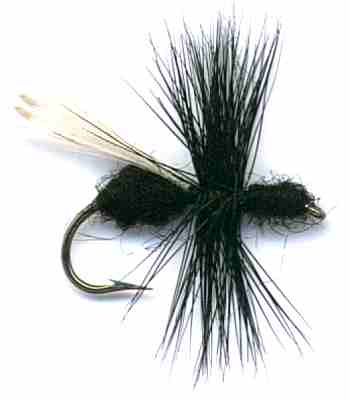The Flying Black Ant Dry Fly
Every serious fly fisher should carry a selection of flying ants in their fly box at the first sign of new leaves on trees and bushes. These tender leaves attract aphids that leave sweet droppings ants love to sip. Its also a signal that there will soon be a flying ant fall and trout go nuts over flying ants.

FLYING BLACK ANT DRY FLY PATTERNS. Hook size 18 16 14 12 10 - $US each
A Scientist studied the eating habits of rainbow, brown and Brook trout during the months of July/August and found that no other food dominated their menu so heavily as ants. The proportion in some of the trout was as much as 80%. Flying ants swarm at this time of the year. They 'rain' down on lakes and rivers by their billions and attract fish to the surface. At the beginning of a swarm when the ants fall rather sparsely, the fish are easy to catch. During the peak of the swarm the real ants are too numerous and a fish rarely takes an imitation by mistake, but the situation changes again towards the end of the swarm. For weeks after the fish are obsessed with this source of food and ant flies are remain one of the best flies to use. Even when there are no swarms have a look at over hanging trees. If ants are climbing up their trunks, exploring the leaves for food, some will fall. A floating ant fly might just tempt that hungry trout lurking in the shade. The English Fly Fishing Shop carries a range of black and red ant flies. Ants may be fished very simply, like freely drifting dry flies. As the fish find them easily enough, no special tricks are required.
It may seem strange that trout would prefer to eat land based insects over the many aquatic bugs available to them. You must remember that unlike hatching mayflies they are available to the fish virtually all year round. Trout have an entire season to learn what they look and taste like. They must be considered by the fish as an abundant dependable surface floating pray. Ant patterns will catch trout anywhere unlike mayfly patterns where you should try and match the hatch. Even when there are hatches on the water some time during the day there will be at least one lengthy period when few flies are hatching. This normally occurs in the afternoon. This is the time to get out an ant pattern. If you come across a picky feeder who will not take your mayfly pattern, do not abandon it without showing the fish an ant fly. Once when I was on vacation I arrived on a river completely unprepared for the large hatch of tiny Blue winged olives. I didn't have any dry fly small enough. I tried a few ant flies and managed to tempt a few of the feeders away from the mayfly feast.
LINKEDIN COMMENT
I love using ant patterns in all of their forms. Great fly to have in the box at all times. Yes, when the wind blows fish feed on ants that fall from the trees and any other bugs too. Scott Feltrinelli Owner and guide at Ontario Fly Outfitters
LINKEDIN COMMENT
Close imitations to what you see on the water or the banks is the key to fishing Ants, my box has size 12 through 18 in black, red, redand black and cinnamon. I fish them dead drift in lakes or rivers and the cooler days of fall seem to put allot of these insects on the water. I like to sight fish cruising fish in lakes and intercept their course with a bloating Ant. Leader must be sunk and I think most refusals and not the fault of the fly, the fish has seen the leader. The Ant is a very underused fly and Trout love them. - Mike Guinn
LINKEDIN COMMENT
My home stream has a dense canopy of sycamores, maples,oaks and other deciduous trees overhanging most of its length. Thus ants are falling in with every bird landing or stiff breeze. I often fish a "fur ant" as the bottom fly in a two nymph rig. I tie my wet ants with quick descent dubbing or a wrap of lead. Ants are heavier than water and they only float until breaking through the surface tension. Try this, push a live ant under...it won't pop back up like a grasshopper or other terrestrial. Ants are buff with the BMI of a college wrestler. They sink to roll along the bottom like any other macro. Fish 'em dry but also fish 'em deep! Bill Anderson - President of Little Juniata River
Association and fly fishing instructor
LINKEDIN COMMENT
On the Bow River and local streams I use them on windy days, and during the High Water season. I carry a variety of ties to assist in matching the hatch. Paul Morrell
GOOGLE+ READER'S COMMENT
A #16 in rusty brown works well here in California. No wing and sparse hackle. Fish it under the willows or just down from them when the breeze picks up a bit. Trout candy, they love'em. Winged ants here in my area are rare but a black #18 with a long wing will match the hatch. Up in Northern California the wood ants get huge. A black #12 isn't too big. Fished like all terrestrials, dead drift close to the bank. Earl Arnold, Oxnard
LINKEDIN COMMENT
I use traditional ant patterns when there is no hatch yet I have a hope that trout will rise to a terrestrial pattern. Ant patterns are very effective at times. By Bruce Rueben
Fly Fishing books



